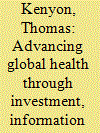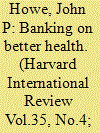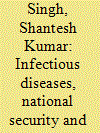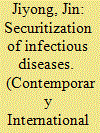|
|
|
Sort Order |
|
|
|
Items / Page
|
|
|
|
|
|
|
| Srl | Item |
| 1 |
ID:
132540


|
|
|
|
|
| Publication |
2014.
|
| Summary/Abstract |
The past decade has witnessed unprecedented levels of investment and engagement in global health spurred by the global HIV/AIDS crisis, the development of the Millennium Development Goals, momentum in polio eradication, and global outbreaks of infectious diseases such as SARS with its US$40 billion cost to society. Characterized by a sense of urgency, pragmatism, and opportunity, global health services and public health systems are being advanced to respond to rapidly expanding demands with dramatic results. However, much more remains to be done. After a decade in emergency mode, the next phase of global health work requires an even more precise approach and smarter investments. Many "donor" nations and organizations have tightened their belts in response to the recent economic downturn, while at the same time increasing the numbers of "recipient" countries, and are now better able to invest more of their own resources to benefit and protect their own citizens. In this climate, global health investments in programs and innovations must be better targeted and better informed by strategic information more than four-fold from US $6.7 billion in 1993 to US $28.4 billion in 2011. Accompanying this investment was a striking decline in mortality in children under five years of age from 12.6 million deaths in 1990 to 6.6 deaths million in 2012. Improvements in health are not the only positive outcome of these investments. The same Commission concluded that global health is a smart investment - for every dollar invested in health, it can be expected that there will be a 10-20 fold return in economic benefit to society. Healthier people are more productive and contribute back to the economy. Healthier people also lower health care costs, naturally, by requiring less care.
|
|
|
|
|
|
|
|
|
|
|
|
|
|
|
|
| 2 |
ID:
132541


|
|
|
|
|
| Publication |
2014.
|
| Summary/Abstract |
HIV is no longer a death sentence" - that hopeful declaration-which would have been unthinkable even a decade ago- has now become a cliché by repetition whenever experts, physicians, academics and journalists gather to chart progress in fighting the disease and to set goals for the future. But for many people, sadly, that statement is not actually true. There remains no cure for the disease, and not everyone can get access to the anti-retrovirals (ARVs) that have done so much to help so many. This reflects the painful truth that poverty remains a major impediment to good health in the developing and even the developed world.
|
|
|
|
|
|
|
|
|
|
|
|
|
|
|
|
| 3 |
ID:
126257


|
|
|
|
|
| Publication |
2012.
|
| Summary/Abstract |
Biosecurity measures are traditionally applied to laboratories, but they may also be usefully applied in highly specialized clinical settings, such as the isolation facilities for the management of patients with highly infectious diseases (eg, viral hemorrhagic fevers, SARS, smallpox, potentially severe pandemic flu, and MDR- and XDR-tuberculosis). In 2009 the European Network for Highly Infectious Diseases conducted a survey in 48 isolation facilities in 16 European countries to determine biosecurity measures for access control to the facility. Security personnel are present in 39 facilities (81%). In 35 facilities (73%), entrance to the isolation area is restricted; control methods include electronic keys, a PIN system, closed-circuit TV, and guards at the doors. In 25 facilities (52%), identification and registration of all staff entering and exiting the isolation area are required. Access control is used in most surveyed centers, but specific lacks exist in some facilities. Further data are needed to assess other biosecurity aspects, such as the security measures during the transportation of potentially contaminated materials and measures to address the risk of an "insider attack."
|
|
|
|
|
|
|
|
|
|
|
|
|
|
|
|
| 4 |
ID:
165537


|
|
|
|
|
| Summary/Abstract |
Shantesh Kumar Singh notes the growing importance of health as a critical factor in human and national security due to its links with the economy, the stability of state institutions and public morale. Worsening socioeconomic inequalities are responsible for the vulnerability of both disadvantaged and affluent populations. Reforms of the current economic system are needed to comprehensively address the challenges posed by communicable viral and microbial infections.
|
|
|
|
|
|
|
|
|
|
|
|
|
|
|
|
| 5 |
ID:
061059


|
|
|
|
|
| Publication |
Amsterdam, IOS Press, 2004.
|
| Description |
xvii, 255p.
|
| Series |
NATO science series
|
| Standard Number |
1586034170
|
|
|
|
|
|
|
|
|
|
|
|
Copies: C:1/I:0,R:0,Q:0
Circulation
| Accession# | Call# | Current Location | Status | Policy | Location |
| 049546 | 303.625/KOC 049546 | Main | On Shelf | General | |
|
|
|
|
| 6 |
ID:
097857


|
|
|
|
|
|
|
|